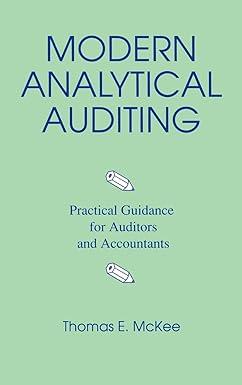Question
Franklin Fireplace Inserts manufactures two premium models of fireplace inserts that provide more BTUs of heat per cord of wood than any other wood burning
Franklin Fireplace Inserts manufactures two premium models of fireplace inserts that provide more BTUs of heat per cord of wood than any other wood burning fireplace insert or stove. One model, the Heatilator, sells for $1,800, and the Heat Queen, a new model that sells for $1,200. Franklins marketing department suggested that the company should concentrate on the new Heat Queen model and begin to phase out the Heatilator model.
Franklin currently uses a traditional costing system. The following cost information has been used as a basis for pricing decisions over the past year.
Per-Unit Data Heatilator Heat Queen
Direct materials $200 $280
Direct labor hours 1.5 1.5
Machine hours 5.0 4.0
Units produced 11,000 4,000
Direct labor cost is $20 per hour, and the machine usage cost is $18 per hour. Manufacturing overhead costs were estimated at $4,800,000 and were allocated on the basis of machine hours.
Gwen Freely, the new company controller, suggested that an activity-based costing analysis first be performed to obtain a better picture of the true manufacturing cost. The following data were collected:
Activity Center Cost Driver Traceable Costs
Soldering Number of solder joints $ 942,000
Shipments Number of shipments 860,000
Quality control Number of inspections 1,240,000
Purchase orders Number of orders 950,400
Machining Machine hours 57,600
Machine setups Number of setups 750,000
Total traceable costs $4,800,000
Number of Events during the year:
Activity Heatilator Heat Queen Total
Soldering 296,250 96,250 392,500
Shipments 4,050 950 5,000
Quality control 14,050 5,325 19,375
Purchase orders 20,025 27,495 47,520
Machining 44,000 4,000 48,000
Machine setups 4,000 3,500 7,500
Selling, general, and administrative costs per unit sold are $175.00 for Heatilator and $125 for Heat Queen.
a. Calculate the manufacturing cost per unit for Heatilator and Heat Queen under:
1. A traditional costing system
2. The ABC system
b. Explain the differences in manufacturing cost per unit calculated in part (A).
c. Which system would most likely do a better job of measuring costs for this product emphasis/keep or drop decision? Explain.
d. Franklins controller points out that the ABC information could also be used to identify and eliminate non-value added activities. Explain how ABC and ABM can be used for this purpose.
Step by Step Solution
There are 3 Steps involved in it
Step: 1
To solve this question and provide a detailed answer we will perform the following calculations and explanations step by step Well first calculate the manufacturing cost per unit under both the tradit...
Get Instant Access to Expert-Tailored Solutions
See step-by-step solutions with expert insights and AI powered tools for academic success
Step: 2

Step: 3

Ace Your Homework with AI
Get the answers you need in no time with our AI-driven, step-by-step assistance
Get Started


